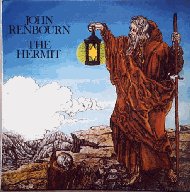|
The Hermit
Transatlantic TRA336 (1976)

Album available as:-
(Shanachie SH97014)
Other Releases:-
(Shanachie Records CD 97014, Castle Communications ESM CD 436. A double
CD with 'The Lady and the Unicorn)
 Buy it now!
Buy it now!
Renbourn's
first post-Pentangle (or nearly post-Pentangle) solo album, joined
briefly by fellow guitarist Dominique Trepeau and featuring further
contributions by John James, is one of his most beautiful recordings,
and also among his most spare guitar instrumentals. Some of the material
is drawn from lute and harp sources, and it is ear-opening to hear
some of the more familiar pieces among the latter (such as "O'Carolan's
Concerto") transcribed for guitar, but Renbourn isn't above adapting
themes from television commercials, either. The mood of much - though
not all - of this record is one of serious introspection, as Renbourn
stays generally within a classical guitar mode. He has fun with the
material, and the CD booklet also includes musical transcriptions
of some of the tunes on the record, for the benefit of Renbourn's
fellow guitarists.
- Bruce Eder (AMG)
Track
Listing
1.
The Hermit (Renbourn) - 3:15
This is the sort of tune that most guitar players put together sooner
or later. It is made up entirely of short phrases that fit nicely on the
guitar and can usually be rolled into something that resembles an instrumental
2.
Old Mac Bladgitt (Renbourn) - 3:59
This is an upright iron grand type of tune, a little worn on the felts.
I use the tuning DGDGBD but somehow manage to avoid actually playing in
the key of G major
3.
Caroline's Tune ( Renbourn, Trepeau) - 3:20
Dominique Trepeau came over from Paris to stay for a few days and we put
together this duet version of his tune while he was here
4.
Three Pieces By O'Carolan (O'Carolan) - 3:58
Turlough O'Carolan, the blind harpist and poet, occupies a unique position
in the history of Irish music. He is thought of as being the last of the
Irish Bards and during his lifetime he was held in high regard for the
quality of his compositions and also feared for the sharpness of his tongue.
He was renowned for his love of good whisky which is the theme and inspiration
of a number of his finest works. After his death, brought about by a period
of enforced abstinence, his skull is said to have been preserved by the
country people and used as a drinking vessel for a cure for epilepsy.
5.
The Lamentation of Owen Roe O'Neill - 0:40
The Lament for the dead is a very old and important class of Irish music.
This piece is in honour of General Owen Roe O'Neill who led the Irish
against Cromwell and was the hero of the Victory of Benburb. His death
in 1649 laid Ireland open to the Cromwellian settlement. His tune is printed
in Captain Francis O'Neil's 'Music Of Ireland'. Lord Inchiquin (1:46)
The subject of this piece is probably the 4th Early of Inchiquin who
succeeded to the title in 1719 and lived in County Clare. The source is
the Bunting manuscript in the Library of Queen's University, Belfast.
Mrs. Power (O'Carolan's Concerto) (1:41) This is one of O'Carolan's
best known compositions. It comes from a time when Italian composers were
enjoying much favour in the great houses of Ireland and is said to have
been composed spontaneously by O'Carolan in a contest of musical skills
with violinist Geminiani when they were both quests of the Irish nobleman
Lord Mayo'. (I know this tune best as 'Flatback Caper' from Liege and
Lief by Fairport Convention! - LK)
6.
The Princess And The Puddings - 2:00
This is a short tune in E minor which is an extension of a 45 second background
piece commissioned by the makers of some famous fruit pies. the construction
is genuine Mock Tudor.
7.
Pavanna (Anna Bannanna) - 3:40
A little tune respectfully dedicated to the young daughter of a prominent
guitarist. This is played in a tuning commonly used by guitarists for
vihuela and lute music.
8.
Toy For Two Lutes - 1:27
'This is taken from the Thomas Robinson 'School of Musicke' published
in 1603, which contains a number of solo pieces and duets for the lute'
9.
Lord Willoughby's Welcome Home - 5:28
'This appears to been a very popular Elizabethan tune. There are settings
for solo lute by Thomas Robinson and Nicholas Vallett (as Soet Robbert),
also by Dowland with a second part added anonymously and an arrangement
by Bird in the Fitzwilliam Virginal Book as 'Rowland'. It seems that the
tune was made popular by Will Kemp and his players who accompanied Robert
Dudley, Earl of Leicester, to the Netherlands. When Leicester was disgraced
and recalled he was succeeded by Lord Willoughby and, in the hope of finding
a new patron, Kemp renamed the tune in his honour' (with John James on
guitar)
John Renbourn - Guitar
John James - Guitar on Track 9
Dominique Trepeau - Guitar on Track 3
|


